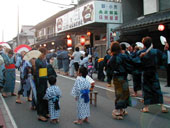“The full moon” and Bon Dancing
And next, we cannot ignore the relation between the fact that the people dance at night and the natural phenomena of “the full moon”.*1
Especially, since the lunar calendar corresponds to the waxes and wanes of the moon, July 15, which is the middle day of Bon was always full moon. This is not an accident, and many folk events in Japan arrange the dates in accordance to the lunar age.*2
The cultures that recognize a mysterious meaning in the moon light can be seen all around the world.
Anyway, please imagine.
At least, in the Edo era, when the whole nation used the lunar calendar, literally the whole nation danced all night with Bon Dancing in the night of the full moon on July 15, which came once a year. It might have appeared as a people who love to dance very much to the foreigners. We could call this “Japan, the archipelago of Bon Dancing”
*1 “Tsuki ga deta deta, tsuki ga deta (The moon rose, the moon came up)”: A lyric of a Bon Dancing song that is most widely sung in Japan. (Tanko bushi (A song of coal mining region)).
*2 “Nihon no min-you to buyou (The folk songs and dances of Japan)” written by Haruo Misumi and published by Osaka Shoseki notes that there was a belief such as: “The spirits of the ancestors returned by taking a ride on the moon light in Obon”
As for “the full moon”, we cannot ignore the aspect of its stage effects. This must have been rather important for the young people who were the main character of the dance.
In the old time when there was no petroleum or electricity, the light of the full moon was precious light source. The moonlight had enough brightness to dance. Also, the soft light of the moon has a romantic stage effect. In the Bon Dancings that were held in towns, with the mood of the traditional streets, (and also with the effect of the dim light which makes people look more beautiful than they actually are), the men and women might have looked more beautiful than usual. Bon Dancing was also an important place for the romance of men and women.
The persistence to “Tetsuya Odori (All night dancing)”
And now, and at last, we have come to the stage to mention about the “Tetsuya Odori (All night dancing)”. Tetsuya Odori is in every sense one of the most wonderful traditions of the Bon Dancing culture in Japan. And also it is Tetsuya Odori which gives us the utmost charm of “dancing in the night”.
“What a freak you are to dance even all night long !”. This is the impression I had when I first heard the word, Tetsuya Odori in Gujo Hachiman. In fact however, in the old times it was natural to dance Bon Dancing all night in any region.
The biggest reason is, as we mentioned before, is the fact that “night = the time to dance”. In Japan, there were various folk customs that spent the night without having a sleep, such as New Year’s Eve.*1Additionally, in the old times when there were fewer opportunities for entertainment than today, people may have strongly thought that they wanted to enjoy Bon Dancing completely since this is the largest amusement throughout the year.
In the crackdown during the Meiji era, the tradition of all night dancing was strictly contolled together with the move of the dancing site, and vulgarian lyrics. Also, various circumstances of the modern urban community makes difficult to conserve and hand down these traditions of all night dancing.
*1In the book “Kurashi no naka no minzokugaku (Folklore in the day-to-day life)” published by Yoshikawa Koubunkan, Haruo Itabashi introduces various figures of folk customs that has to do with “night”. I really wish he mentioned about Tetsuya Odori.
However, in the regions that are handing down the Tetsuya Odori (All night Dancing), are making various efforts and devices, and thereby showing strong persistence to this traditional culture.*2
The enchantment that the repeating monotonic dance makes. With the advance of the night, only the dance lovers remain, and the sound of the handclap and footsteps becomes equal and beautiful. In the light of the dawn, the rhythm becomes gradually faster as it comes closer to the final dance. And the tiredness and the contentment you have after the dance ends. Everyone who have participated in the dance praises the splendor.
The time of Bon Dancing must be “night” by any means. We must be proud of this amazing culture, and would like to hand it down for the future to come.
*2 For instance, the Tetsuya Odori becomes aborted “only when the weather alert is anounced”. They dance even in any big rainfall besides the alert. It can be considered that this is because the attraction of Tetsuya Odori is entrancing the people of the region.
People dance in the light of daybreak (Niino Bon Dancing 2000.8.16)

